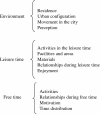Barriers, facilitators and preferences for the physical activity of school children. Rationale and methods of a mixed study
- PMID: 22978490
- PMCID: PMC3490845
- DOI: 10.1186/1471-2458-12-785
Barriers, facilitators and preferences for the physical activity of school children. Rationale and methods of a mixed study
Abstract
Background: Physical activity interventions in schools environment seem to have shown some effectiveness in the control of the current obesity epidemic in children. However the complexity of behaviors and the diversity of influences related to this problem suggest that we urgently need new lines of insight about how to support comprehensive population strategies of intervention. The aim of this study was to know the perceptions of the children from Cuenca, about their environmental barriers, facilitators and preferences for physical activity.
Methods/design: We used a mixed-method design by combining two qualitative methods (analysis of individual drawings and focus groups) together with the quantitative measurement of physical activity through accelerometers, in a theoretical sample of 121 children aged 9 and 11 years of schools in the province of Cuenca, Spain.
Conclusions: Mixed-method study is an appropriate strategy to know the perceptions of children about barriers and facilitators for physical activity, using both qualitative methods for a deeply understanding of their points of view, and quantitative methods for triangulate the discourse of participants with empirical data. We consider that this is an innovative approach that could provide knowledges for the development of more effective interventions to prevent childhood overweight.
References
-
- Martínez-Vizcaíno V, Sánchez López M, Moya Martínez P, Solera Martinez M, Notario Pacheco B, Salcedo Aguilar F, Rodríguez-Artalejo F. Trends in excess weight and thinness among Spanish schoolchildren in the period 1992–2004: the Cuenca study. Public Health Nutr. 2009;12:1015–1018. doi: 10.1017/S1368980008003571. - DOI - PubMed
-
- Cattaneo A, Monasta L, Stamatakis E, Lioret S, Castetbon K, Frenken F, Manios Y, Moschonis G, Savva S, Zaborskis A. et al.Overweight and obesity in infants and pre-school children in the European Union: a review of existing data. Obes Rev. 2010;11:389–398. doi: 10.1111/j.1467-789X.2009.00639.x. - DOI - PubMed
Publication types
MeSH terms
LinkOut - more resources
Full Text Sources
Medical


